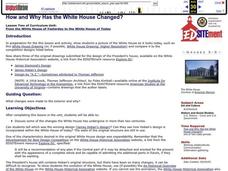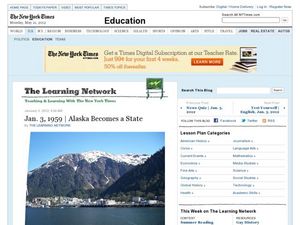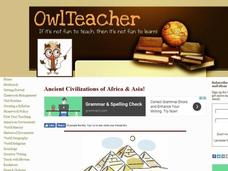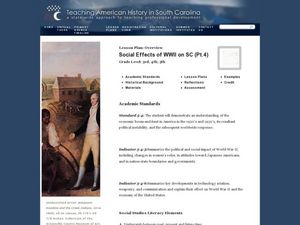Facing History and Ourselves
How Should We Remember?
We must remember the past in order to avoid its mistakes. Young historians analyze the importance of historical remembrance using primary and secondary documents, as well as video clips. They then study the creation of a World War II...
Annenberg Foundation
Analyzing Artifacts
If only a mask could talk! Using the interactive tool along with historical thinking skills, pupils uncover the meaning behind the various materials the resource presents. History becomes more relevant as the artifacts tell their stories...
Curated OER
Stone Tools of Texas Indians
Provide background information regarding the use of stone tools from the paleoindian through the late prehistoric periods. Learners can read this informational passage to gain insight on how and why we study these amazing artifacts from...
PBS
Cardboard History
A PBS clip focused on collecting sports memorabilia launches this research project lesson. Class members then read Dan Gutman’s Honus and Me in which Wagner’s baseball card is used to time travel. The lesson ends with researchers...
Curated OER
Lesson: Tlatelolco: Mexican Student Massacre 1968
The Massacre of Tlatelolco is the focus of a discussion-based lesson. Civil-minded learners consider the nature of student movements that have ended in violence based on over-reaction and government oppression. They discuss the social...
Curated OER
Kentucky in the Civil War
Seventh graders consider how Kentucky was involved in the Civil War. In this American Civil War lesson, 7th graders view PowerPoint presentations on the topic and then discuss the state's neutrality policy and eventual secession....
Center for History and New Media
Slavery and Free Negroes, 1800 to 1860
What was life like for enslaved and free black people before the American Civil War? Explore the building tension between states and the freedom of individuals with a thorough social studies lesson. Learners of all ages explore primary...
Annenberg Foundation
America's History in the Making: Using Digital Technologies
How can digital technology of today link us to the events of the past? Scholars use technology to uncover the vast number of historical resources available in lesson 12 of a 22-part America's History in the Making series. Using databases...
Curated OER
How and Why Has the White House Changed?
Young scholars examine changes the White House has undergone in the past two centuries. They view and discuss online images and designs, compare diagrams, read information from various websites, and answer discussion questions.
Curated OER
Vocabulary Review: Government Terms
As your English language pupils learn about the government and vocabulary words commonly used when talking about the government, present them with this worksheet. There are eight multiple choice questions, and each vocabulary word is...
US National Archives
The Royal Seal What Can It Tell Us?
Analyze the images and details of the Great Seal of Queen Elizabeth I, and discover clues that reveal how one of the greatest monarchs in the history of England wished to be seen and respected. This is a great way to discuss how even to...
Curated OER
The Roots of the Arab-Israeli Conflict: 1890s-1947
Consider and examine the roots of the Arab-Israeli conflict during the turn of the century. The topics covered in this presentation are not fully explained but are a perfect accompaniment to a full lecture. Issues to examine include The...
Curated OER
Egypt
A fascinating presentation on the historical, physical, and cultural geography of Egypt awaits your pupils in this fine PowerPoint. Some excellent photographs of the landscape are included, as well as some fine examples of the Egyptian...
Curated OER
Jan. 3, 1959 | Alaska Becomes a State
Make connections with past history and current events with this critical thinking exercise. Kids read background information relating to Alaska's statehood as well as information on oil drilling and Alaska's economy. They put it all...
Curated OER
Claudette Colvin: Twice Toward Justice
Use the historical account of Claudette Colvin to study civil rights and connect past injustices to modern issues. As learners read, they examine chapter titles, record quotes, and participate in discussion. Next, they research active...
Owl Teacher
Teach Ancient Civilizations: Africa
Amazing! Teach learners about the wonders of ancient Africa and Asia with a comprehensive set of teaching tools. You'll click to find a well-constructed presentation, a worksheet that has kids compare and contrast ancient alphabets, a...
Curated OER
The Great Military: Map of Texas
The battle at the Alamo may be one of the most famous military campaigns in Texas history, but it is by no means the only one. As part of their study of the military history of Texas, class members research less-well-known sites, locate...
Annenberg Foundation
America's History in the Making: Classroom Applications Four
The final installment of a 22-part American history series examines the many faces that make up the country's story. From Henry Ford to Tulio Serrano, scholars use biographical evidence and Internet research to uncover the people behind...
Curated OER
Houghton Mifflin Social Studies/Chapter 13, Lesson 1 The Past Shapes the Future (pp. 292-295)
Fourth graders reflect upon the events of the past in order to make cognitive connections to present or future history. Students use Blooms Taxonomy to attain higher levels of thinking.
Curated OER
Social Effects of WWII on South Carolina
Students study the history of South Carolina and the impact World War II had on the state. In this WWII history lesson, students research the social effects incurred from WWII on the people of South Carolina. Students develop an outline...
Curated OER
Land Use Change Introduction
Students discuss the major changes that have taken place in the Hudson Valley over the past 400 years. They use aerial photos to describe major trends in Dutchess County. Students view a PowerPoint presentation. They work in small groups...
Curated OER
Analyzing the economic, political, social, and cultural transformation of the United States since World War II
Eleventh graders examine political issues in the United States between 1936 and 2000. For this American history lesson, 11th graders study the economy, education, government, civil rights, and sports of this time period. Students compare...
Curated OER
An Interview With the Past: Ancient Roman and U.S. Government Leaders
Students produce a modern television interview show where they present information about Ancient Rome and its influence on modern governments. In this governments lesson plan, students produce shows in groups.
Curated OER
Social Effects of WWII
Fifth graders study the social effects of World War II on America. In this WWII effects instructional activity, 5th graders read paragraphs about the history of World War II. Students watch a video about the period and formulate...

























